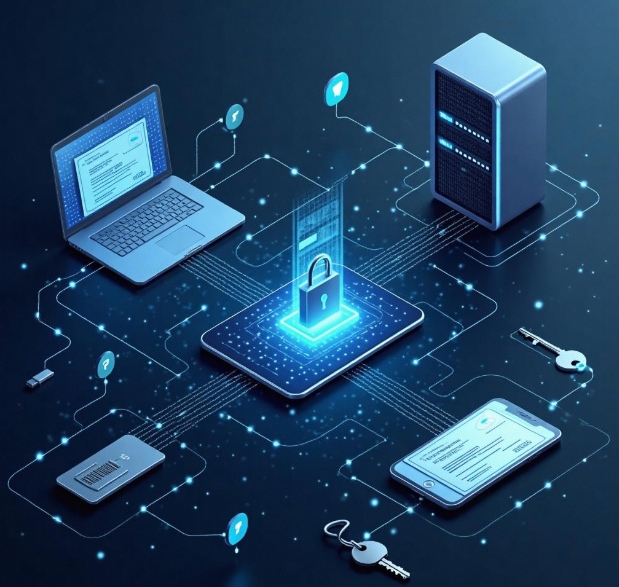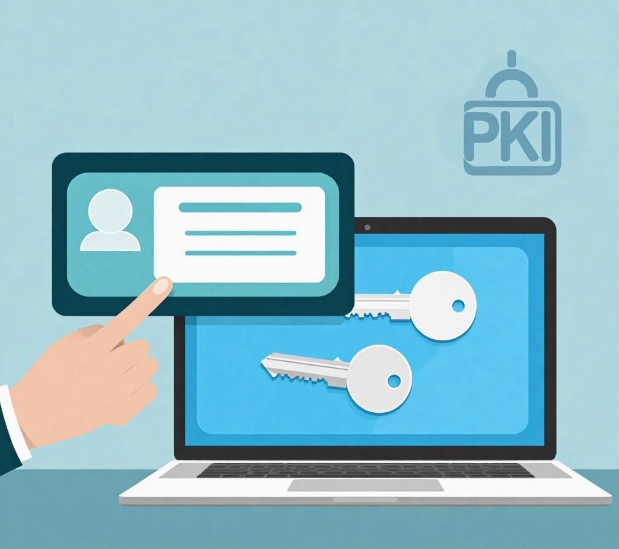Device Authentication and Identity Verification in IoT Development
- latest articles
- 1.DApp Development & Customization: Merging Diverse Market Needs with User Experience 2.Analysis of the Core Technical System in DApp Project Development 3.How to achieve cross-chain interoperability in Web3 projects? 4.How does the tokenization of points reconstruct the e-commerce ecosystem? 5.How to Set and Track Data Metrics for a Points Mall? 6.What is DApp Development? Core Concepts and Technical Analysis 7.Inventory of commonly used Web3 development tools and usage tips 8.Development of a Distribution System Integrated with Social E-commerce 9.Six Key Steps for Businesses to Build a Points Mall System 10.What is DApp Development? A Comprehensive Guide from Concept to Implementation
- Popular Articles
- 1.Future Trends and Technology Predictions for APP Development in 2025 2.Analysis of the DeFi Ecosystem: How Developers Can Participate in Decentralized Finance Innovation 3.From Zero to One: How PI Mall Revolutionizes the Traditional E-commerce Model 4.DAPP Development | Best Practices for Professional Customization and Rapid Launch 5.How to Develop a Successful Douyin Mini Program: Technical Architecture and Best Practices 6.Recommended by the Web3 developer community: the most noteworthy forums and resources 7.From Cloud Computing to Computing Power Leasing: Building a Flexible and Scalable Computing Resource Platform 8.Shared Bike System APP: The Convenient Choice in the Era of Smart Travel 9.How to Create a Successful Dating App: From Needs Analysis to User Experience Design 10.From Design to Development: The Complete Process of Bringing an APP Idea to Life
With the rapid development of Internet of Things (IoT) technology, an increasing number of devices, sensors, applications, and human terminals are being connected to the internet, forming a vast network system. IoT has not only achieved significant results in fields such as smart homes, healthcare, and transportation but has also profoundly impacted various industries including business and industry. However, the proliferation and application of IoT devices also pose unprecedented challenges to cybersecurity. Ensuring device security, reliability, and information confidentiality has become a critical issue in the development of IoT.
In the development process of IoT, device authentication and identity verification are essential components for ensuring system security. Device authentication and identity verification not only help prevent unauthorized device access but also ensure that communication between legitimate devices and users is not maliciously tampered with. This article will explore the concepts, methods, technologies, and practical applications of IoT device authentication and identity verification.
I. Overview of IoT Device Authentication and Identity Verification
IoT device authentication refers to verifying the identity of devices accessing the IoT system through certain means to ensure they are legitimate and trustworthy. Device authentication typically involves two important aspects: confirming the device's identity and ensuring that device data is not tampered with during transmission.
Identity verification, on the other hand, is the process of confirming identity between devices or users and the system. Whether it's user login, device registration, or data transmission, the core purpose of identity verification is to ensure that every entity in the system is authorized and legitimate.
The process of IoT device authentication and identity verification typically includes the following steps:
Device Registration: When a device first connects to the network, it needs to undergo identity registration, and the system assigns it a unique identifier.
Identity Verification: When a device communicates, the system needs to verify whether the device's identity is legitimate.
Data Encryption and Authentication: During data transmission between the device and the server, data encryption and authentication are performed to prevent data leakage and tampering.
II. Technologies and Methods for IoT Device Authentication
Public Key Infrastructure (PKI)-Based Authentication
Public Key Infrastructure (PKI) is the most common method for IoT device authentication. PKI uses a public and private key pairing mechanism to achieve identity verification between devices. In this system, each device has a pair of public and private keys; the public key is used for encrypting data, while the private key is used for decryption and identity authentication.
During device registration, the device submits its public key to a certification authority, which issues a digital certificate. The digital certificate, signed by the certification authority, proves the legitimacy of the device's identity. When communicating with other devices or servers, the device can use its private key to sign messages, and the receiver uses the public key to verify the signature's validity, thereby confirming the authenticity of the device's identity.
Symmetric Encryption-Based Authentication
Unlike PKI, symmetric encryption uses the same key for both encryption and decryption. In IoT device authentication, if both parties pre-share a key, device authentication can be achieved through symmetric encryption. During communication, both parties use the same key to encrypt data, ensuring data integrity and confidentiality.
The advantage of symmetric encryption is that the algorithm is relatively simple and performs well, making it suitable for resource-constrained devices. However, the drawback is that key management is more complex, and if the key is compromised, it could affect the security of the entire system.
Biometric-Based Identity Authentication
As IoT devices become increasingly widespread, especially in fields like smart homes and healthcare, biometric technology is being introduced into device authentication and identity verification. Through biometric features such as fingerprint recognition, iris recognition, and facial recognition, user identity can be effectively verified.
Although biometric technology offers high security, its application in device authentication still faces challenges. For example, it requires higher hardware specifications, and the accuracy and real-time performance of recognition need continuous improvement.
III. Challenges and Solutions for IoT Device Identity Verification
Device Diversity and Heterogeneity
The IoT involves a wide variety of devices, including sensors, smart home devices, industrial control systems, etc. These devices differ in hardware, software platforms, communication protocols, and other aspects, making it a challenge to design universal and efficient identity verification mechanisms. To accommodate diverse devices, modular and hierarchical authentication methods are often adopted. For example, in the authentication process between devices, a layered authentication mechanism is used to first verify the hardware layer and communication protocol layer, followed by identity verification to confirm the device's legitimacy.
Device Resource Constraints
Many IoT devices, especially sensors and embedded devices, have relatively limited resources. Their computational power, storage capacity, and communication bandwidth are far inferior to computers or smartphones. Therefore, balancing security and resource consumption during device identity verification is a critical issue. To address this, lightweight authentication protocols and algorithms have been proposed, such as hash-based authentication protocols, which can effectively complete identity verification tasks without compromising device performance.
Key Management
In IoT systems, the vast number and widespread distribution of devices make effective key management a challenge. Key distribution, storage, and updates involve the overall security of the system. Improper key management can lead to vulnerabilities in device identity authentication. To solve this problem, dynamic key management strategies can be adopted, such as regularly updating keys and using hardware security modules (HSM) to store keys, ensuring key security.
IV. Practical Applications of IoT Device Authentication and Identity Verification
Smart Homes
In smart homes, multiple devices such as smart bulbs, smart locks, and smart thermostats form a networked system. Device authentication and identity verification are crucial for ensuring the security of the home environment. For example, smart locks need to ensure that only authorized users can unlock them, and smart cameras need to ensure that their recorded data is not tampered with by external parties. Through technologies like PKI and symmetric encryption, each device can be effectively authenticated and verified, preventing hackers from attacking the system by impersonating devices or users.
Healthcare Devices
With the application of IoT technology in the medical field, an increasing number of healthcare devices are closely related to patients' lives. These devices not only need to collect health data in real-time, such as heart rate, blood sugar, and blood pressure, but also ensure data accuracy and security. For example, in telemedicine, doctors diagnose patients based on data received from their devices. To ensure that this data has not been tampered with, devices must undergo identity verification to confirm that their source is legitimate and trustworthy.
Industrial IoT (IIoT)
In the Industrial IoT, device security is particularly important. Industrial devices such as sensors, surveillance cameras, and PLCs (Programmable Logic Controllers) need to operate in harsh environments. Any vulnerability in identity authentication could lead to production interruptions or data breaches in the entire factory. By adopting multi-factor authentication technologies, it is possible to ensure that each device undergoes strict verification when accessing the industrial control system, thereby enhancing system security and reliability.
V. Future Outlook
As IoT technology develops, device authentication and identity verification will become increasingly complex and important. In the future, in addition to existing authentication technologies, more innovative methods may emerge. For example, AI-based intelligent authentication systems could use machine learning and deep learning technologies to analyze device behavior and data flow anomalies, identifying and preventing potential security threats in real-time. Meanwhile, with the development of 5G and edge computing, device authentication and identity verification will play a role in a wider range of application scenarios.
Overall, the continuous advancement of IoT device authentication and identity verification technologies is key to ensuring the secure and stable operation of IoT. As technologies mature and standards become unified, the security of IoT systems will be significantly enhanced, making the future intelligent world more reliable and secure.
-

How to Use IoT Development to Enhance Supply Chain Efficiency
With the rapid development of the global economy and the deepening of digital tr···
-

Development and Innovation of the Internet of Things in the Healthcare Sector
With the rapid advancement of information technology, the Internet of Things (Io···
-

Data Storage and Analysis Methods in IoT Development
The Internet of Things (IoT) is one of the most revolutionary innovations in tod···

 Blockchain
Blockchain












